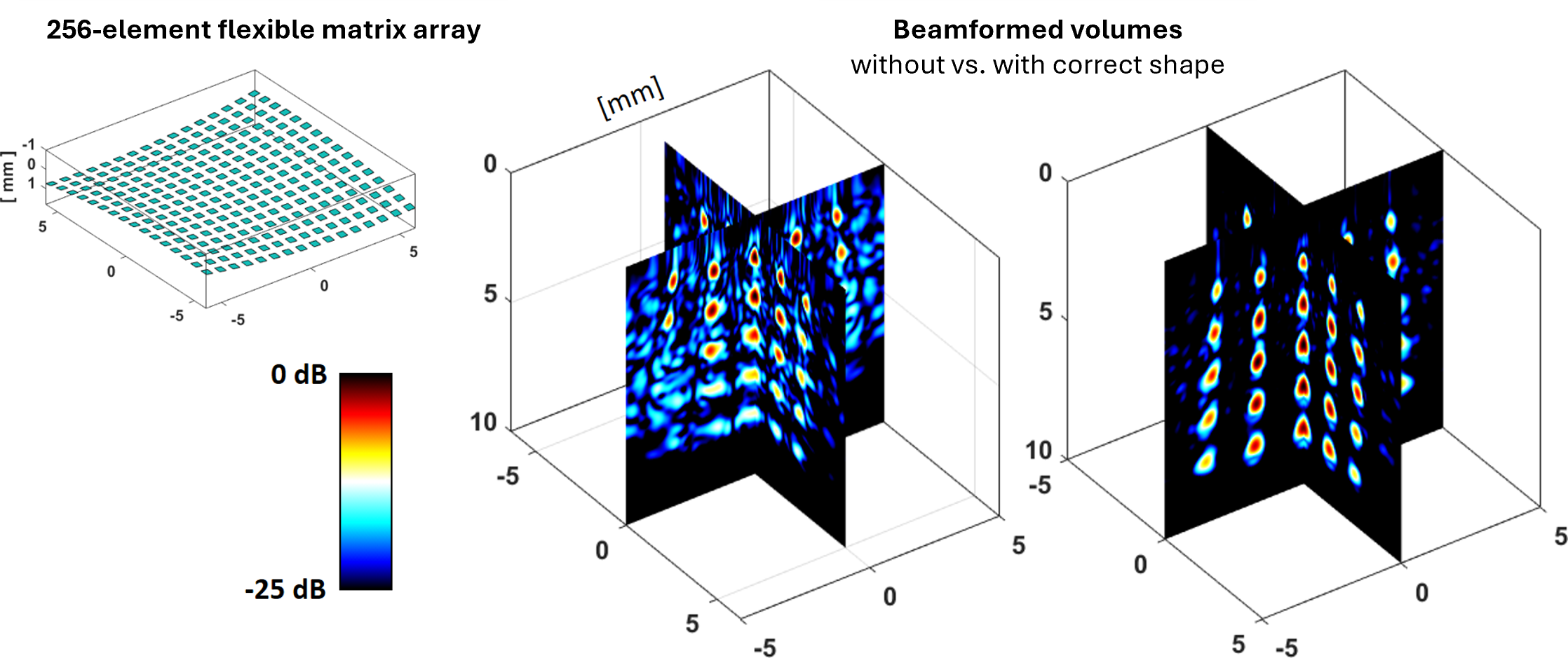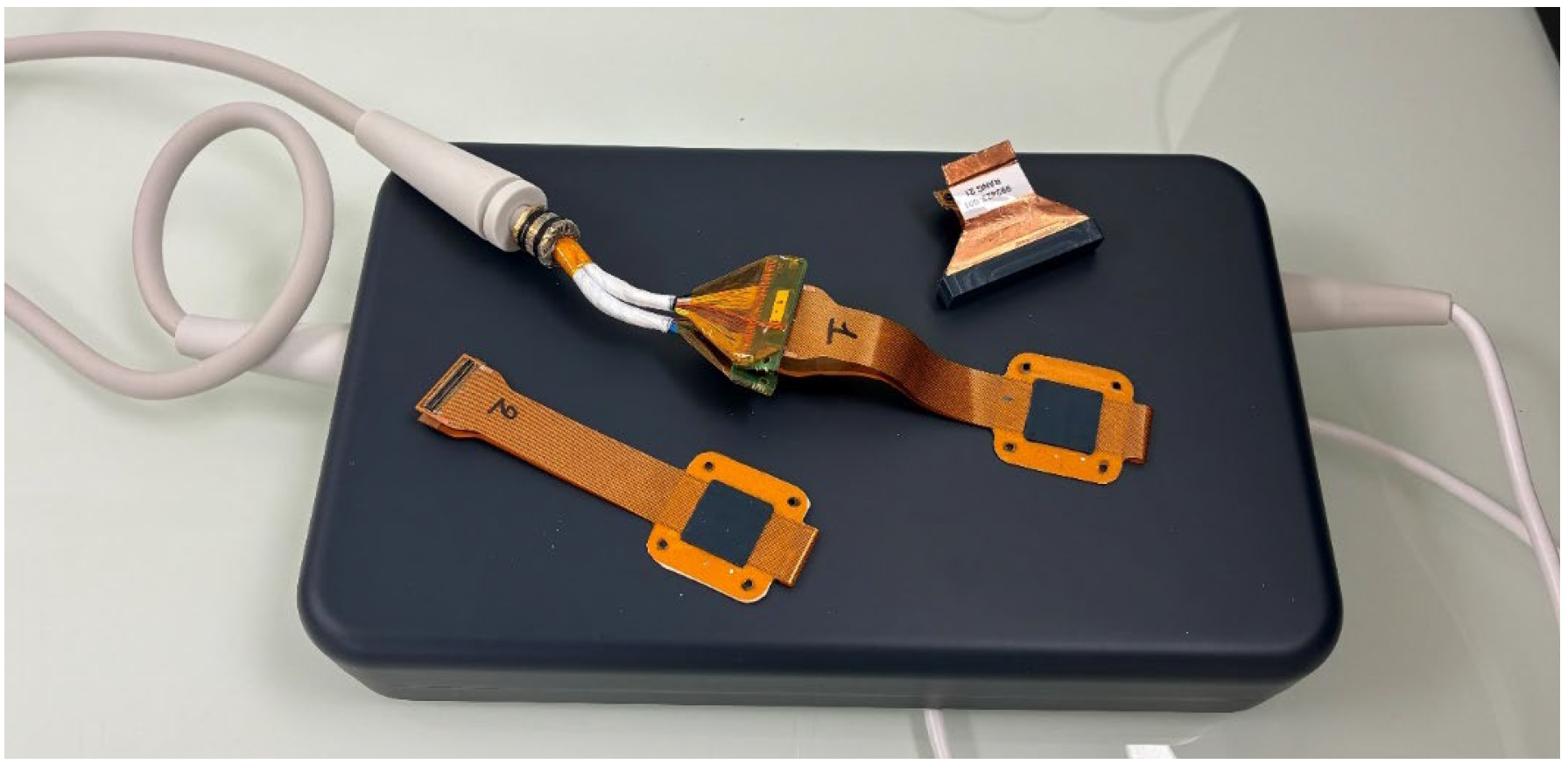Context
Ultrasound echography, along with conventional X-ray, is the most widely used medical imaging modality, and its development over the last decade promises an even more significant role in the future. Whereas the acquisition of images, as well as the corresponding diagnosis, is usually performed by a medical doctor holding a probe in their hand, the appearance of flexible ultrasound probes opens new avenues for this modality, particularly in terms of continuous patient monitoring. Indeed, it has been demonstrated that manufacturing and imaging with such probes is possible [1]. Flexible arrays can be presented as a patch directly fixed on the patient’s skin, whose shape adapts to changing conditions. In addition to the necessity of being driven by wearable electronic systems, they also need to be optimized for compactness, power consumption, material robustness, and other factors. The way the data are acquired and the images are reconstructed must also be adapted to account for the modified geometry of the array. This internship aims to study and develop new solutions for ultrasound image beamforming adapted to flexible arrays.
In the context of this internship, some previous developments have already been started. First, the MUST toolbox has been updated to generate a flexible array, simulate the RF pulse-echo signal, and consider non-regular positioning of the elements in the Delay-and-sum (DAS) beamforming (Figure 1). Secondly, Vermon lent to Creatis an open version of the DKPOC acquisition system, which allows for the control of any array in real-time through a MATLAB interface. Moreover, two 2D flexible arrays are available to acquire signals (Figure 2). However, as illustrated in Figure 1, if the array shape is unknown, the standard DAS beamforming strategy provides a highly degraded image, and adaptive solutions may be found [2], [3]. Moreover, if used in real-time, the array's location may change, leading to real-time shape evolution. In this context, a fast shape estimation strategy will help shift the beamforming hypothesis in real-time.

Figure 1 – Illustration of a flexible array and the generated signal after beamforming without or with the correct shape of the array. We can observe that it is essential to understand the proper shape to reconstruct the US 3D volume.
In summary, the aims of this internship are as follows:
- Conduct a state-of-the-art review of flexible probes in ultrasound imaging, with a focus on beamforming.
- Identify the best approaches in the literature and reprogram them to reference the state of the art.
- Propose an innovative beamforming approach with/without a specific transmission pattern for flexible probes with an unknown surface shape.
- Test all the approaches on the provided experimental system.

Figure 2 – Illustration of the DKPOC system (black box) and some arrays (two 2D flexible arrays and one linear) designed by Vermon.
General information
Profile: Student from a top engineering school or research master’s degree (generalist or EEA profile)
Technical skills: image and signal processing. Ultrasound imaging knowledge is a plus.
Soft skills: Versatility and curiosity, ability to work independently, initiative, good written and oral communication skills.
Start and duration of placement: February/March 2026 for 6 months. Punctual missions to Tours can be envisaged.
Workplace: Creatis, Lyon-Tech La Doua campus.
How to apply
Send CV + cover letter + M1/M2 or engineering school transcripts to:
François Varray, Associate Professor, francois.varray@creatis.insa-lyon.fr
Damien Garcia, Research Director, damien.garcia@creatis.insa-lyon.fr
References
[1] P. L. M. J. van Neer et al., “Flexible large-area ultrasound arrays for medical applications made using embossed polymer structures,” Nat. Commun., vol. 15, no. 1, p. 2802, Mar. 2024, doi: 10.1038/s41467-024-47074-1.
[2] T. Noda, N. Tomii, K. Nakagawa, T. Azuma, and I. Sakuma, “Shape Estimation Algorithm for Ultrasound Imaging by Flexible Array Transducer,” IEEE Trans. Ultrason. Ferroelectr. Freq. Control, vol. 67, no. 11, pp. 2345–2353, Nov. 2020, doi: 10.1109/TUFFC.2020.3004052.
[3] J. Elloian, J. Jadwiszczak, V. Arslan, J. D. Sherman, D. O. Kessler, and K. L. Shepard, “Flexible ultrasound transceiver array for non-invasive surface-conformable imaging enabled by geometric phase correction,” Sci. Rep., vol. 12, no. 1, p. 16184, Sep. 2022, doi: 10.1038/s41598-022-20721-7.
